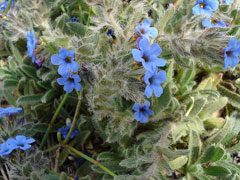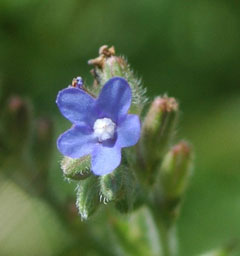 |
|
http://commons.wikimedia.org/wiki/User:Jeantosti |
 |
| http://commons.wikimedia.org/wiki/User:Doronenko |
Translate this page:
Summary
Physical Characteristics

 Alkanna tinctoria is a PERENNIAL growing to 0.2 m (0ft 8in) by 0.3 m (1ft). It is in flower in June. The species is hermaphrodite (has both male and female organs).
Alkanna tinctoria is a PERENNIAL growing to 0.2 m (0ft 8in) by 0.3 m (1ft). It is in flower in June. The species is hermaphrodite (has both male and female organs).
Suitable for: light (sandy) and medium (loamy) soils, prefers well-drained soil and can grow in nutritionally poor soil. Suitable pH: neutral and basic (mildly alkaline) soils. It can grow in semi-shade (light woodland) or no shade. It prefers dry or moist soil and can tolerate drought. The plant can tolerate maritime exposure.
UK Hardiness Map
US Hardiness Map
Synonyms
Anchusa tinctoria.
Plant Habitats
Woodland Garden Dappled Shade; Cultivated Beds;
Edible Uses
Edible Parts: Leaves
Edible Uses: Colouring
Used as a vegetable[177]. No further details are given. A red dye obtained from the roots is used as a food colouring[238].
References More on Edible Uses
Medicinal Uses
Plants For A Future can not take any responsibility for any adverse effects from the use of plants. Always seek advice from a professional before using a plant medicinally.
Antibacterial Antidiarrhoeal Antipruritic Astringent Demulcent Expectorant Vulnerary
The root is antibacterial, antipruritic, astringent and vulnerary[238].It is used externally in the treatment of varicose veins, indolent ulcers, bed sores and itching rashes[238]. Used internally to treat cough and bronchial catarrh (see known hazards above). Used in the treatment of skin wounds and diarrhoea [301].The root is harvested in the autumn and can be dried for later use[238]. All plant parts are demulcent and expectorant [301].
References More on Medicinal Uses
The Bookshop: Edible Plant Books
Our Latest books on Perennial Plants For Food Forests and Permaculture Gardens in paperback or digital formats.

Edible Tropical Plants
Food Forest Plants for Hotter Conditions: 250+ Plants For Tropical Food Forests & Permaculture Gardens.
More

Edible Temperate Plants
Plants for Your Food Forest: 500 Plants for Temperate Food Forests & Permaculture Gardens.
More

More Books
PFAF have eight books available in paperback and digital formats. Browse the shop for more information.
Shop Now
Other Uses
Dye Litmus
A red dye is obtained from the roots[57, 89, 171], it is used by pharmacists as well as in perfumes and to stain wood or marble[100, 238]. The dye is also used in thermometers[100] and as a litmus to test for acids and alkalines[148]. It can make wood look like rosewood or mahogany[4, 148].
Special Uses
References More on Other Uses
Cultivation details
Prefers a well-drained sandy or loamy soil[1] in sun or partial shade[238]. Dislikes acid soils[1] but thrives in alkaline soils[238]. A very drought tolerant plant when established[200], succeeding in a hot dry position[187], it is a useful plant for dry sandy or alkaline soils[238]. Plants are hardy to about -10°c[187]. This species is occasionally cultivated as a dye plant[61]. One report says that it is cultivated for its seed[46].
References Carbon Farming Information and Carbon Sequestration Information
Temperature Converter
Type a value in the Celsius field to convert the value to Fahrenheit:
Fahrenheit:
The PFAF Bookshop
Plants For A Future have a number of books available in paperback and digital form. Book titles include Edible Plants, Edible Perennials, Edible Trees,Edible Shrubs, Woodland Gardening, and Temperate Food Forest Plants. Our new book is Food Forest Plants For Hotter Conditions (Tropical and Sub-Tropical).
Shop Now
Plant Propagation
Seed - sow spring in a cold frame. When large enough to handle, prick the seedlings out into individual pots and plant them out in the summer. Division in spring. Fairly easy, they can be planted straight out into their permanent positions if required. Basal cuttings of new growth in late spring. Harvest the young shoots when they are about 10 - 15cm long and pot them up into individual pots in a lightly shaded position in a greenhouse. They should root well within a few weeks and can be planted out in the summer[K]. Root cuttings in late winter[200].
Other Names
If available other names are mentioned here
Native Range
TEMPERATE ASIA: Cyprus, Israel, Jordan, Lebanon, Syria, Turkey (west) EUROPE: Hungary, Slovakia, Albania, Bulgaria, Greece (incl. Crete), Croatia, Italy (incl. Sardinia, Sicily), Romania, Serbia, Spain, France AFRICA: Algeria (north), Egypt (north), Libya (north), Morocco, Tunisia
Weed Potential
Right plant wrong place. We are currently updating this section.
Please note that a plant may be invasive in one area but may not in your area so it's worth checking.
Conservation Status
IUCN Red List of Threatened Plants Status :

Growth: S = slow M = medium F = fast. Soil: L = light (sandy) M = medium H = heavy (clay). pH: A = acid N = neutral B = basic (alkaline). Shade: F = full shade S = semi-shade N = no shade. Moisture: D = dry M = Moist We = wet Wa = water.
Now available:
Food Forest Plants for Mediterranean Conditions
350+ Perennial Plants For Mediterranean and Drier Food Forests and Permaculture Gardens.
[Paperback and eBook]
This is the third in Plants For A Future's series of plant guides for food forests tailored to
specific climate zones. Following volumes on temperate and tropical ecosystems, this book focuses
on species suited to Mediterranean conditions—regions with hot, dry summers and cool, wet winters,
often facing the added challenge of climate change.
Read More
Expert comment
Author
(L.)Taush.
Botanical References
45200
Links / References
For a list of references used on this page please go here
Readers comment
| Add a comment |
|
If you have important information about this plant that may help other users please add a comment or link below. Only comments or links that are felt to be directly relevant to a plant will be included. If you think a comment/link or information contained on this page is inaccurate or misleading we would welcome your feedback at [email protected]. If you have questions about a plant please use the Forum on this website as we do not have the resources to answer questions ourselves.
* Please note: the comments by website users are not necessarily those held by PFAF and may give misleading or inaccurate information.
To leave a comment please Register or login here All comments need to be approved so will not appear immediately.
|
Subject : Alkanna tinctoria
|
|
|
|